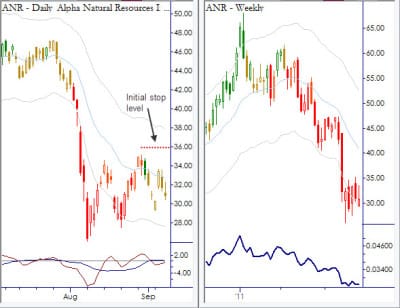Individual Traders
How Do You Calculate Volatility In Excel?
How to calculate a simple historical volatility using Microsoft Excel.
Individual Traders
How to calculate a simple historical volatility using Microsoft Excel.
Failure Test
A failure test that justifies flipping a long position to a short position.
General Comments
[dc]I[/dc] want to share two statistical "studies" with you. Both of these were done this weekend, using the cash S&P index from 1/2/1987 - 10/14/2011. Both show a strong and convincing edge. Without further ado, let's dig into
Individual Traders
A casual understanding of mathematical concepts can often lead to incorrect conclusions. This post shows that the direction of markets on charts does not necessarily reveal anything about the correlation between those two markets.
Individual Traders
[dc]"F[/dc]irst, know your risk." Every trader has heard this, and for good reason: It truly is one of the most important elements of successful trading. Amateur traders get into a trade thinking about all the money they stand to make, while professionals always define the
Individual Traders
[dc]I[/dc] will write more about this in the future, but I want to introduce you to an important concept called volatility compression. From a theoretical perspective, markets tend to operate in one of two modes: in mean reversion mode extremes are quickly reversed. Traders buy dips and sell

General Comments
[dc]I[/dc] want to share with today an example of an actual trade I made in September. Two points before we begin: this is, perhaps, a slightly complex example. If you are unfamiliar with the patterns of trading pullbacks, come back to this post in a few weeks when
Individual Traders
This is the second post in a two-part series, taking a deeper look at the contents of my new book, The Art and Science of Technical Analysis, to be published early 2012. The first post can be found here. PART IV: THE INDIVIDUAL, SELF-DIRECTED TRADER CHAPTER 12: THE TRADER’S

Individual Traders
PART I: THE FOUNDATION OF TECHNICAL TRADING CHAPTER 1: THE TRADER’S EDGE Most losing traders lose because they do not truly understand the nature of the challenge before them. They do not understand the market, how it works, or the task of creating a profitable trading system. Sadly, much
Individual Traders
This is the third post in a series. Please read part 1 and part 2 first. So if you've gotten this far you see the title of this series maybe should have been So You Really Want to be a Trader? I don't mean to be
Failure Test
A look at the technical position of the S&P Index 10/6/11. Illustrates use of simple technical patterns and relationships to derive an edge.
Individual Traders
This post is a continuation from the first post in this series, and the last post can be found here. In that first post, I suggested a set of books to build a good foundation for market knowledge. Most of those topics were foundational, somewhat abstract, and removed from actual